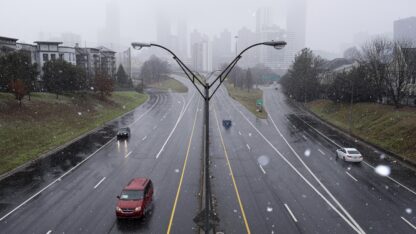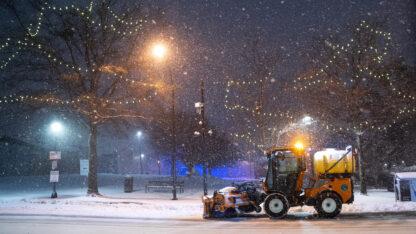This story is part of WABE and American Graduate’s Advancing Atlanta: Education series. For more stories, click here.
In science class at the Galloway School in Buckhead, fifth grader Sophie Orston is making a sculpture of a microorganism.
“I put two bottle caps together, and now I’m putting bubble wrap about it,” she explained. “Then, I am going to put some netting around the bubble wrap”
Audrey Smith, who is sitting next to her, took a different approach. “I took a golf ball, and I peeled the shell off of it. I cut off the bottom the end of an egg carton and wrapped that around.”
The rest of the classroom is littered with coke bottles, golf tees, six pack rings, wires, tennis balls, caps and other materials that could be found around the house. They are all recycled goods.
The students have been studying viruses and bacteria this year, hence why they are making microorganisms, but it does not explain why they are doing art in science class.
Their teacher, Roy Lander, recently got a grant through the National Oceanic and Atmospheric Administration. He and the students are doing a larger environmental project on plastic bags, but he wanted to make sure there was room in the budget for an art component.
“I think everyone here at Galloway is looking to try anything that we can to help every child learn,” he said. “So, if I had a kid in here that doesn’t really respond to some of the traditional things, if I can incorporate art and that gets them interested, I’m all willing to do that.”
Lander has a Masters in STEM (Science, Technology, Engineering and Math) education. He was also one of 10 teachers from the United States who went to the Paris climate talks last December.
But the STEAM method, incorporating art into the STEM fields, is gaining more ground in schools.
To help Lander with the art side of the project is local artist Amandine Drouet.
Drouet uses found and recycled materials in her own work. She and fellow artist and microbiologist Dena Light have gone into several schools to do art projects that raise awareness about the environment, and they have done those projects in art classes, technology classes and science classes.
They make sure to incorporate what kids are learning in their school into the art project. Sophie, who is using bottle caps and bubble wrap, is sculpting a virus she did a previous modeling project on.
“I’m doing my virus, which is shingles; it’s like chicken pox but you get it when you are older,” she explained. “It’s really cool.”
The students are not limited to making their microorganism or even a real one. Kayla Kessler made one out of a tennis ball container, which she explained would be a deadly virus. She said, “I’m just trying to make something that looks like a virus because we could make something imaginary. Imagination is a big part of learning.”
Adding art to the science class was supposed to stir the imagination, according to Light. She said, “There were many kids were imagining what other bacteria could look like. So, they’re taking all these components that they learned and they’re imagining more, and I think that’s what science is about.”
At Galloway, teachers often develop interdisciplinary activities that involve art. In these fifth graders’ language arts class, they read “The Little Prince” and then drew pictures of the characters.
Lander’s first experience with an extensive interdisciplinary project was a few years ago when the Terracotta Army was at the High Museum. At that time, students learned about the composition of different sorts of clay in science class. In art, they built miniature soldiers that they had scaled down in math. In language arts, students recorded diary entries as if they were the warriors.
Back in science class, Chace Rumley made three virus models named Squibby, Scubert and Squish. When asked about what she thought about making art in science class, she said, “Well I think that it’s a way of learning because some people learn by listening. Other people learn by doing … So, I think this is an interactive way to learn about virus and bacteria.”
According to STEAM research conducted by the University of Florida, when art is combined with one of the STEM fields in a school activity, it deepens understanding in both areas.
With this art project, the fifth graders learned about the environment and how to reuse household goods creatively. They also strengthened their understanding of microorganisms by putting their knowledge of flagella and cytoplasm to work.
With all the individual sculptures completed, Drouet and Light helped the students assemble an installation inside the school.
Interdisciplinary STEAM programs have also been linked to improved personal skills, like collaboration and cross cultural understanding. Drouet said that personal skills is another important aspect of bringing the creative process into the classroom.
“I think it builds confidence and [you don’t feel] like you’re a failure because you aren’t doing it the right way,” she said. “In my opinion, there is not right way to do it.”
The benefits of interdisciplinary learning probably aren’t going through these fifth graders’ minds at all given moments, bur for them, it’s fun to mix up the science class routine.
This story is part of American Graduate, Let’s Make It Happen, a public media initiative made possible by the Corporation for Public Broadcasting.










